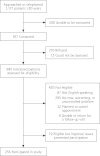Intervention to enhance communication about newly prescribed medications
- PMID: 23319503
- PMCID: PMC3596029
- DOI: 10.1370/afm.1417
Intervention to enhance communication about newly prescribed medications
Abstract
Purpose: Physicians prescribing new medications often do not convey important medication-related information. This study tests an intervention to improve physician-patient communication about newly prescribed medications.
Methods: We conducted a controlled clinical trial of patients in 3 primary care practices, combining data from patient surveys with audio-recorded physician-patient interactions. The intervention consisted of a 1-hour physician-targeted interactive educational session encouraging communication about 5 basic elements regarding a new prescription and a patient information handout listing the 5 basic elements. Main outcome measures were the Medication Communication Index (MCI), a 5-point index assessed by qualitative analysis of audio-recorded interactions (giving points for discussion of medication name, purpose, directions for use, duration of use, and side effects), and patient ratings of physician communication about new prescriptions.
Results: Twenty-seven physicians prescribed 113 new medications to 82 of 256 patients. The mean MCI for medications prescribed by physicians in the intervention group was 3.95 (SD = 1.02), significantly higher than that for medications prescribed by control group physicians (2.86, SD = 1.23, P <.001). This effect held regardless of medication type (chronic vs nonchronic medication). Counseling about 3 of the 5 MCI components was significantly higher for medications prescribed by physicians in the intervention group, as were patients' ratings of new medication information transfer (P = .02). Independent of intervention or control groups, higher MCI scores were associated with better patient ratings about information about new prescriptions (P = .003).
Conclusions: A physician-targeted educational session improved the content of and enhanced patient ratings of physician communication about new medication prescriptions. Further work is required to assess whether improved communication stimulated by the intervention translates into better clinical outcomes.
Figures



Similar articles
-
Life disruptions for midlife and older adults with high out-of-pocket health expenditures.Ann Fam Med. 2013 Jan-Feb;11(1):37-42. doi: 10.1370/afm.1444. Ann Fam Med. 2013. PMID: 23319504 Free PMC article.
-
Post-Visit Patient Understanding About Newly Prescribed Medications.J Gen Intern Med. 2021 Nov;36(11):3307-3310. doi: 10.1007/s11606-020-06540-4. Epub 2021 Feb 5. J Gen Intern Med. 2021. PMID: 33547568 Free PMC article.
-
Nature and frequency of exchanges on medications during primary care encounters.Patient Educ Couns. 2006 Dec;64(1-3):207-16. doi: 10.1016/j.pec.2006.02.003. Epub 2006 Jun 15. Patient Educ Couns. 2006. PMID: 16781108
-
Reducing medication errors and increasing patient safety: case studies in clinical pharmacology.J Clin Pharmacol. 2003 Jul;43(7):768-83. J Clin Pharmacol. 2003. PMID: 12856392 Review.
-
Medicines adherence: involving patients in decisions about prescribed medicines and supporting adherence: Clinical guideline.London: National Institute for Health and Care Excellence (NICE); 2009 Jan 28. London: National Institute for Health and Care Excellence (NICE); 2009 Jan 28. PMID: 39480983 Free Books & Documents. Review. No abstract available.
Cited by
-
Training physicians in providing complex information to patients with multiple sclerosis: a randomised controlled trial.BMJ Open. 2022 Mar 15;12(3):e049817. doi: 10.1136/bmjopen-2021-049817. BMJ Open. 2022. PMID: 35292486 Free PMC article. Clinical Trial.
-
Infrequent older adult-primary care provider discussion and documentation of dietary supplements.J Am Geriatr Soc. 2014 Jul;62(7):1386-8. doi: 10.1111/jgs.12915. J Am Geriatr Soc. 2014. PMID: 25039511 Free PMC article. No abstract available.
-
Integrating Quantitative and Qualitative Results in Health Science Mixed Methods Research Through Joint Displays.Ann Fam Med. 2015 Nov;13(6):554-61. doi: 10.1370/afm.1865. Ann Fam Med. 2015. PMID: 26553895 Free PMC article.
-
Assessment of the steps taken towards avoidance of medication errors among hypertensive outpatients attending a tertiary health care facility in Nigeria: a cross-sectional study.Pan Afr Med J. 2019 Jun 3;33:76. doi: 10.11604/pamj.2019.33.76.13594. eCollection 2019. Pan Afr Med J. 2019. PMID: 31448038 Free PMC article.
-
Development and Initial Validation of the Communication About Medication by Providers-Parent Scale (CAMP-P).Glob Pediatr Health. 2019 Jul 1;6:2333794X19857980. doi: 10.1177/2333794X19857980. eCollection 2019. Glob Pediatr Health. 2019. PMID: 31309130 Free PMC article.
References
-
- Tarn DM, Heritage J, Paterniti DA, Hays RD, Kravitz RL, Wenger NS. Physician communication when prescribing new medications. Arch Intern Med. 2006;166(17):1855–1862 - PubMed
-
- Shrank WH, Polinski JM, Avorn J. Quality indicators for medication use in vulnerable elders. J Am Geriatr Soc. 2007;55(Suppl 2): S373–S382 - PubMed
-
- Knight EL, Avorn J. Quality indicators for appropriate medication use in vulnerable elders. Ann Intern Med. 2001;135(8 Pt 2):703–710 - PubMed
-
- Murray MD, Morrow DG, Weiner M, et al. A conceptual framework to study medication adherence in older adults. Am J Geriatr Pharmacother. 2004;2(1):36–43 - PubMed
-
- Falvo D, Woehlke P, Deichmann J. Relationship of physician behavior to patient compliance. Patient Couns Health Educ. 1980;2(4):185–188 - PubMed
Publication types
MeSH terms
Grants and funding
LinkOut - more resources
Full Text Sources
Other Literature Sources
Medical
